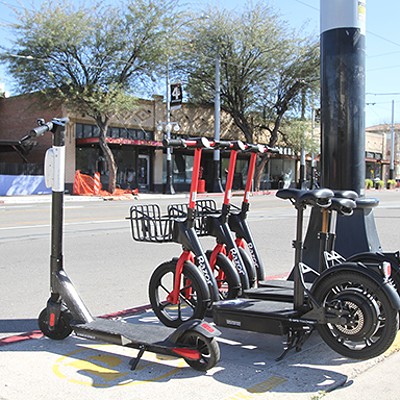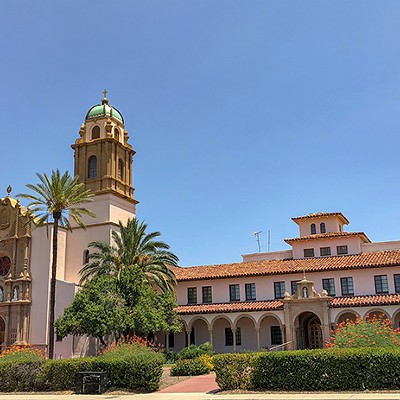"A pitiful eyesore," said one self-appointed sage.
"Not worth saving," argued another.
"Look to the future," chanted the wrecking-ball chorus. "A waste of taxpayer money. Tear it down, and sooner rather than later."
Marist College? Nope. Thirty years ago, the preservation point of contention was downtown's circa-1927 Temple of Music and Art. The venerable Scott Avenue building had been bought by a developer who quickly announced plans to replace it with a five-story office building. But local folks rose up to protest that demolition; today, the Temple is a thriving cultural hub, and the home to the Arizona Theatre Company. It's hard to imagine that anyone ever entertained notions of tearing it down.
Which brings us to Marist, a mere two blocks away. Dating from 1915, the unique, multistory adobe is now undergoing the same short-sighted tribulations. But this story may not end so happily.
Salvation did seem at hand in July, when the Tucson City Council allocated $1.1 million of its federal Community Development Block Grant allotment toward stabilizing the building, under the banner of blight abatement.
But it didn't take long for that move to get snagged on the same political draglines that have condemned so many of our city's historic properties. Foremost among them was the notion of dipping into Tucson's share of federal funds to rescue a building still owned by the Roman Catholic Diocese of Tucson. To get around that, the city suggested transferring ownership of the building, which is next to St. Augustine Cathedral, to a limited liability partnership. That move would also have made the property eligible for federal tax credits geared toward restoration.
Besides, the diocese long insisted that it would happily bequeath ownership of Marist to the city upon the asking.
"Originally, the idea was for the city to take over the building, and use funds they claimed they had for (restoration)," diocese property and insurance director John Shaheen told me in August. "They asked if we'd be willing to give them the property and the building, and we said, 'If it's good for the community, and it's good to save the building, then let us know what we need to do.'"
But when that answer finally came, the diocese waffled.
On Sept. 11, City Manager Richard Miranda dispatched a memo declaring that church officials had decided against transferring ownership of Marist. As a result, Miranda wrote, the CDBG funds would be directed elsewhere. And thus evaporated several years of hard work by preservation activists and city leaders, which included getting Marist listed on the National Register of Historic Places.
"The Diocese wants the building to be saved by use of CDBG funds, but only if it can retain property ownership because of its location adjacent to the Cathedral," Monsignor Al Schifano said in a church statement, also released on Sept. 11. The city "also expected repayment of the CDBG funds," Schifano wrote.
Regarding this flip-flop, diocese spokeswoman Steff Koeneman points to concerns that the building could be left to the vagaries of the commercial real-estate market, and possibly even slip into default. "Then there would be no way to know what would become of the property," she says, "right there in proximity to the cathedral."
But if that's the case, why suddenly raise such red flags after years of negotiation?
Ward 1 Councilwoman Regina Romero said the diocese's move came as a disheartening surprise, and may be due to a simple misunderstanding. Romero has long pushed for restoration of Marist; she says she views saving the Marist as "restorative justice" for the surrounding barrio, where so many adobes were bulldozed in the 1960s under the banner of urban renewal.
Romero claims the church also misunderstood her July motion to allocate the $1.1 million in CDBG funds to mean that the money would have to be reimbursed. "But my motion was saying, 'If you sell that building to anyone outside, for even $10, that needs to come back to the city to use for CDBG blight abatement,'" Romero says. "Unfortunately, I think (the diocese) was listening to one council member, as opposed to the real motion that night."
That would be Ward 6 Councilman Steve Kozachik, who Romero says has been "obnoxiously loud" in his opposition to the deal.
Apparently, Kozachik's steadfast opposition to rescuing Marist with public funds did draw the attention of John Shaheen and Bishop Gerald Kicanas, who approached him following the council vote. "They were concerned, because they had been told (by city officials) that this was the only thing that the CDBG money could be used for," Kozachik says. "I pointed out to them that was, in fact, not accurate, and that the CDBG money could be rolled over to the next fiscal year and be used for a variety of things, such as low-income housing renovations.
"I told them I was doing the same thing they and their congregation were doing: 'You looked at your priorities, and your congregation said that it made more sense to use your limited funds for your social needs than restoring the Marist.'"
According to Kozachik, the diocese was even talking to local developer Peach Properties about renovating Marist, "when the city stepped in and said, 'Hey, we found a million bucks for you.' And that changed the whole conversation."
Peach Properties owner Ron Schwabe didn't return a phone call seeking comment.
For its part, the diocese has repeatedly claimed that it can't afford to rescue Marist. That may be true, Kozachik says. "But if the diocese wants to save its building, they should lobby the Catholic Church writ large—which is not a destitute organization—and say, 'This is something that is really meaningful to the church.' But they don't seem to care."
An email seeking comment from Sister Mary Ann Walsh, spokeswoman for the United States Conference of Catholic Bishops, was not returned.
The Marist saga angers preservation activist Ken Scoville, who calls the diocese's failure to maintain its building "demolition by neglect."
Although the Catholic Church is the oldest institution in this region, it seems eager to disregard its own history, he says. "Why would they feel more comfortable with a parking lot than seeing the building put back together?"
While costs for fully renovating Marist are estimated at around $3 million, Scoville argues that demolition costs alone would top $500,000. And he notes that nobody has squawked at that price tag.
"It's always fascinating to me," he says, "that money always seems to be available when we want to destroy something."












